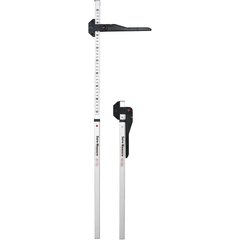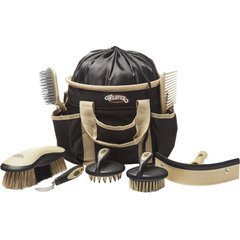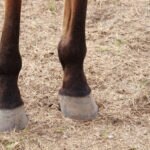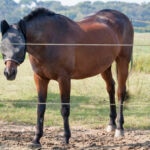Pony vs. Horse: What’s the Difference?

Photo by mgstudyo/iStock / Getty Images Plus via Getty Images
Fluffy, chubby, and cute are all apt descriptions for a pony, while horses are often seen as majestic, athletic, and beautiful. But how exactly can you tell the difference between a pony and a horse? At what height does a pony end and a horse begin?
What's the Difference Between a Horse and a Pony?
The main difference between a horse and pony is based on height measurement.
Horses and ponies are both measured in a unit called a hand, which is equal to 4 inches. Back before there were rulers and tape measures, the width of a man’s hand was an easy way to do measurements.
A decimal point is used as a rough estimate for any inches—one, two, or three—above a full hand. For example, a pony that is 53 inches tall would be 13.1 hands (13 hands and 1 inch).
To measure a horse or pony, an L-shaped measuring stick is used with one end placed on the ground and the measurement taken at the withers (the bony part where the neck and the back meet).
Recommended Product
Horse Height vs. Pony Height
- Miniature Horse: No more than 8.2 hands
- Small Pony: 12.2. hands and under
- Medium Pony: 12.3–13.2 hands
- Large Pony: 13.3–14.2 hands
- Horse: 14.3 hands and above

Photo by Chewy
What About Mini Horses vs. Ponies?
The main difference between a miniature horse and a pony is undoubtably their size.
Mini horses are much smaller, sometimes even almost half the size of a pony. A mini horse can be no taller than 8.2 hands.
The other difference is how they are bred. Miniature horses are bred to be exactly that—a smaller version of many of the well-known horse breeds—while a pony is mainly bred for their height.
Pony vs. Horse Appearance: What Do They Look Like?
You may be able to tell a horse and a pony apart from just their height, but there are many other characteristics that make each of them unique.
Horses are athletic, muscular, and well-built for speed, endurance, and agility. They typically have an average mane and tail length and thickness. One exception is draft horses, which are stockier breeds that originate from Europe. They have thick manes and tails, and most have very thick hair around their legs called feathers.
Common horse breeds include:
Ponies, on the other hand, are usually rounder and have a wider build since it’s easier for them to gain weight. Their manes and tails are usually longer and thicker, somewhat resembling a draft horse. A pony’s coat is usually longer and thicker during the winter months.
Ponies can be extremely athletic if bred well like a horse, but most ponies are used for children, trail riding, and pulling carts, and have traditionally been seen more as working animals.
Some of the most popular pony breeds include:
- Shetland
- Welsh Cob
- Pony of the Americas (POA)
- Dartmoor Pony
Caring for Ponies vs. Horses
Although horses and ponies may seem like they need the same care, there are some major differences in what each of them need.
Hoof Care
Both horses and ponies need regular hoof care and trimming every four to eight weeks; however, depending on their exercise level, one may need shoes more often than the other.
Remember to pick your horse or pony’s feet on a regular basis.
Recommended Product
Coat Care
Because ponies typically have much thicker and longer coats, they require a little extra maintenance in this department. Mud, brush, and parasites love to hang out in thick fur, so it’s important to routinely brush and bathe our pony friends!
Some extra maintenance you might see with a pony might include:
- Combing and washing out the feathers on their legs
- Braiding manes and tails to keep them snarl-free from the wind and brush
- Performing extra fur checks for sneaky parasites
All that being said, horses as well as ponies require coat care—it might just be a little less labor-intensive with a horse.
Recommended Product
Feeding Guidelines for Different Body Types
Horses should be fed about 1.5–2.5% of their body weight in food per day, while ponies should be fed 1–2% of their body weight per day.
This is because ponies are generally known as “easy keepers,” which means they tend to gain weight much faster than horses and need less intake to maintain their energy.
Work with your veterinarian to develop a diet plan that is suitable for your horse or pony.
And remember to feed treats in moderation, especially to our pony friends! You may even consider a low-sugar grain or treat selection.
Recommended Products
What To Know About Pony vs. Horse Health
As easy keepers, ponies are susceptible to diseases such as equine metabolic syndrome (EMS), Cushing’s disease, and many orthopedic problems.
For horses, disease risk varies greatly on the breed. For example, Arabians may acquire inherited genetic diseases such as cerebellar abiotrophy (CA), lavender foal syndrome (LFS), severe combined immunodeficiency (SCID), and occipitoatlantoaxial malformation (OAAM).
Stockier horse breeds such as the Quarter Horse and Appaloosa are more prone to muscle diseases such as hyperkalemic periodic paralysis (HYPP) and polysaccharide storage myopathy (PSSM).
Both horses and ponies are susceptible to colic and parasites. Always make sure your horse or pony receives a regular dewormer. They should also have fecal tests for parasites every year as well as to guide parasite treatment.
In addition, all horses and ponies should be vaccinated against viruses such as equine influenza, equine herpesvirus (EHV), equine infectious anemia (EIA), and West Nile virus.
Talk to your vet to determine which dewormer and vaccine protocols are right for your horse.
This content was medically reviewed by Kaela Schraer, DVM.








